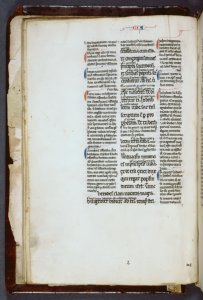The Creation of Medieval Manuscripts: From Binding to Writing Support
emiller0718
«Previous page
•Page 1
•Page 2
•Page 3
•Page 4
•Page 5
•Page 6
You are here •Page 7 •Page 8 •Page 9 •Page 10 •Page 11 •Page 12 •Page 13 •Page 14 •Page 15 •Page 16 •Page 17 •Page 18 •Page 19 •Page 20 ♦Endnotes »Next page
You are here •Page 7 •Page 8 •Page 9 •Page 10 •Page 11 •Page 12 •Page 13 •Page 14 •Page 15 •Page 16 •Page 17 •Page 18 •Page 19 •Page 20 ♦Endnotes »Next page
33
Glossing
Glosses in manuscripts can be found in three places— the margins, interlines, or gathered together at the end of a section. There are lexical glosses which help readers determine meanings of difficult words, and there are suppletive glosses that helped distinguish what words were referring to. If the gloss was small, the scribe could write it in above the main text it related to. As time in the Middle Ages passed, glossing grew forcing scribes to create new types of page layouts. Biblical studies was a major force for innovation in page layouts. Sometimes a leaf would containing more lines of biblical commentary on it than the lines from the Bible it was discussing. Scribes had to get creative and think up new ways to line the leafs.



